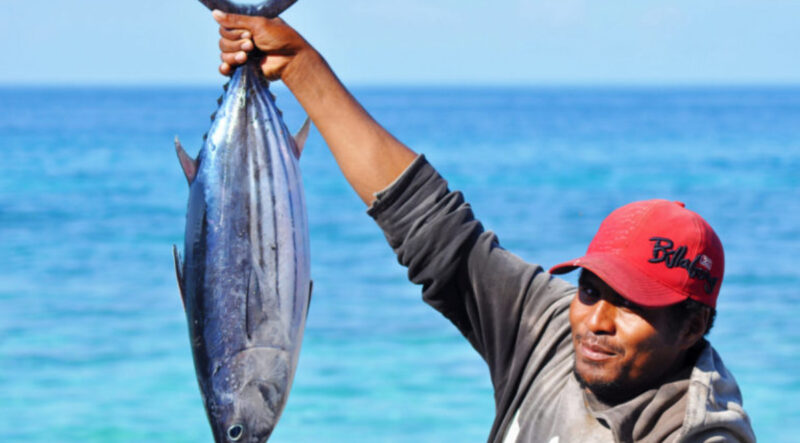Net gains: Aquaculture news from around the world
Asia’s appetite for Scottish salmon grows as Tasmania and America look to build a more robust aquaculture industry.
By SeaWestNews
SCOTLAND – Scottish salmon is now the UK’s biggest food export, with sales reaching £578million (about CAD $975 million) in 2022 followed by bread and pastries, chocolate, cereals, and cheese. Latest figures from Salmon Scotland show that exports to Asia have more than doubled to £24 million (about CAD $40 million) in the first three months of this year, driven by strong demand from China, Taiwan, Singapore, and South Korea. Salmon Scotland believes that there are further opportunities for growth in North America and Asia due to rising consumer demand and ongoing efforts to reduce trade barriers. The trade body also recently unveiled an ambitious growth plan for Scotland’s premium ‘Label Rouge’ salmon to target European markets, aiming to increase its share to 15 percent by 2026. Scotland’s farm-raised salmon sector directly employs more than 2,500 people in Scotland and supports over 3,600 suppliers and an additional 10,000 indirect jobs.
INDONESIA – Indonesia is developing tuna farming in an effort to boost its aquaculture sector and lift some pressure from the world’s largest marine tuna fisheries, reports Mongabay.
Indonesia catches more tuna than any other country, accounting for about 16% of the world’s total tuna supply. However, intensive fishing of wild tuna from the country’s waters has made the fishery unsustainable, with much of Indonesia’s fishing grounds in the Pacific and Indian oceans already fully exploited, and many tuna species subject to overfishing. At the start of his second term in office, in 2019, President Joko Widodo ordered the fisheries ministry to boost the country’s aquaculture productivity. Global aquaculture production grew by 527% from 1990-2018, with Indonesia among the top producers worldwide.
TASMANIA – A salmon farming industry that is economically successful, environmentally responsible, socially beneficial and well-managed is at the forefront of the Tasmanian Salmon Industry Plan 2023. Tasmania’s Primary Industries and Water Minister Jo Palmer said through hard work, innovation, dedication and investment, Tasmania’s salmon industry had become the single biggest primary industry sector in our state, contributing $650 million annually to the Tasmanian economy. “This contributes greatly to our regional economies, employing about 2000 Tasmanians directly and makes broader contributions through supporting transport, feed and many other businesses in the supply chain,” Minister Palmer said. The Tasmanian salmon industry is Australia’s most valuable seafood production sector.
USA – New legislation has been introduced in the 118th US Congress to support the expansion of sustainable aquaculture in U.S. communities, which would provide economic, climate and food security benefits. On June 7, Senators Roger Wicker (R-MS) and Brian Schatz (D-HI) joined together to re-introduce the Advancing the Quality and Understanding of American
Aquaculture (AQUAA) Act in the U.S. Senate. Companion legislation in the U.S. House is expected soon. The bipartisan AQUAA Act would establish National Standards for offshore aquaculture and clarify a regulatory system for the farming of fish in the U.S. exclusive economic zone (EEZ). The bill would also establish a research and technology grant program to fund innovative research and extension services focused on improving and advancing sustainable domestic aquaculture. Due to inefficient federal permitting processes, the U.S. ranks only 17th in aquaculture production. Of the total $281.5 billion global aquaculture market, the U.S. is valued at $1.5 billion or 0.5%, and therefore imports up to 80% of the seafood we consume. “The aquaculture industry is growing rapidly, but the lack of a national permitting system for federal waters has held back development and prevented American producers from growing more seafood at home. This legislation would establish comprehensive standards for offshore aquaculture, helping U.S. producers meet the growing demand for fresh, locally-sourced seafood,” said Senator Wicker.
INDIA – Seafood Exporters’ Association of India President Jagdish Fofandi is calling for the improvement of aquaculture infrastructure nationwide and the expansion of shrimp aquaculture into Kerala state, reports Seafoodsource.com. Fofandi, who was recently named the vice president of India’s Marine Products Export Development Authority (MPEDA), told The Hindu his country needs to improve its support for its aquaculture sector and make more land available for shrimp farming. India’s seafood exports in its last fiscal year reached another all-time high USD 8.47 billion up 9 percent year-over-year, up from a then-record USD 7.74 billion in 2021-2022, “backed by steady demand from existing markets and the addition of newer markets,” according to the Financial Express. India has set a goal of reaching USD 14 billion in seafood exports by 2025, the newspaper reported.
Image – A Maluku fisherman shows his catch of skipjack tuna..Image by USAID Indonesia via Wikimedia Commons (Public domain).

